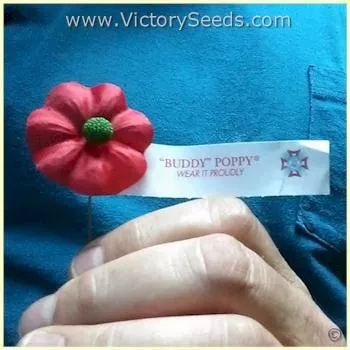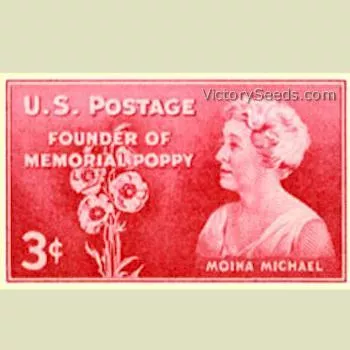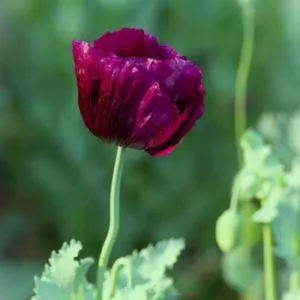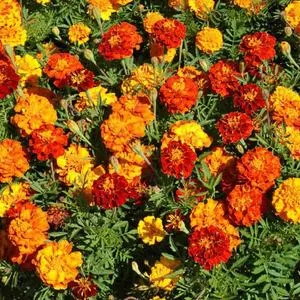



Flanders Poppy
Papaver rhoeas
Price: $3.75
SKU: 1000241Choose a variant:
So common and widespread, its origin remains debated. Prior to the advent of modern herbicides and because the seeds survive for many years in the soil, it was common to see farm fields so filled with them that it looked as if they were under cultivation. This gave rise to its symbol as, and association with, agricultural fertility. This is also the reason it has many common names, such as, 'Field Poppy', 'Corn Poppy', 'Flanders Poppy', 'Red Weed', 'Coquelicot', and simply 'Red Poppy'.
The Red Corn Poppy became forever entwined with World War I and as a symbol of remembrance for the soldiers that died in battle. Due to troop movements, trenching, and extensive disturbance of the soil on battlegrounds, the corn poppies that survived and bloomed in areas between the trench lines and the decimated "no man's lands" on the Western front became known as "The Thin Red Line."
After presiding over the funeral of friend and fellow soldier Alexis Helmer, Canadian Lieutenant-Colonel John McCrae, M.D. penned what is now the famous poem entitled, "In Flanders Fields."
This poem's reference to the red poppies that grew over the graves of fallen soldiers stirred American professor and humanitarian, Moina Belle Michael (1869-1944), into developing the flower into one of the world's most recognized memorial symbols, the "Remembrance Poppy."
These artificial representations of the poppy are distributed by various veterans groups on Memorial Day and worm as a symbol of remembrance for those who lost their lives in service of their country.
'Red Corn Poppy' plants grow twelve to thirty inches tall, prefer locations that receive partial sun and have dry soil. Its bright red flowers bloom in the summer.
The Red Corn Poppy became forever entwined with World War I and as a symbol of remembrance for the soldiers that died in battle. Due to troop movements, trenching, and extensive disturbance of the soil on battlegrounds, the corn poppies that survived and bloomed in areas between the trench lines and the decimated "no man's lands" on the Western front became known as "The Thin Red Line."
After presiding over the funeral of friend and fellow soldier Alexis Helmer, Canadian Lieutenant-Colonel John McCrae, M.D. penned what is now the famous poem entitled, "In Flanders Fields."
In Flanders fields the poppies blow
Between the crosses, row on row,
That mark our place; and in the sky
The larks, still bravely singing, fly
Scarce heard amid the guns below.
We are the Dead. Short days ago
We lived, felt dawn, saw sunset glow,
Loved and were loved, and now we lie
In Flanders fields.
Take up our quarrel with the foe:
To you from failing hands we throw
The torch; be yours to hold it high.
If ye break faith with us who die
We shall not sleep, though poppies grow
In Flanders fields.
Between the crosses, row on row,
That mark our place; and in the sky
The larks, still bravely singing, fly
Scarce heard amid the guns below.
We are the Dead. Short days ago
We lived, felt dawn, saw sunset glow,
Loved and were loved, and now we lie
In Flanders fields.
Take up our quarrel with the foe:
To you from failing hands we throw
The torch; be yours to hold it high.
If ye break faith with us who die
We shall not sleep, though poppies grow
In Flanders fields.
- John McCrae, M.D.
May 3, 1915
May 3, 1915
These artificial representations of the poppy are distributed by various veterans groups on Memorial Day and worm as a symbol of remembrance for those who lost their lives in service of their country.
'Red Corn Poppy' plants grow twelve to thirty inches tall, prefer locations that receive partial sun and have dry soil. Its bright red flowers bloom in the summer.
Genetic Classification: Open Pollinated
Planting Instructions:
For best results, seeds should be surface sown in late winter to early spring. Just sprinkle them where you want them to grow. They are quite tiny so mixing with sand may aid in distribution. Once established, they tend to readily resow.
References:
The U.S. Department of Veterans Affairs states, "Memorial Day, which is observed on the last Monday of May, commemorates the men and women who died while in the military service. In observance of the holiday, many people visit cemeteries and memorials, and volunteers often place American flags on each grave site at national cemeteries. A national moment of remembrance takes place at 3:00 p.m. local time."
Many nations have similar national observances. For example, the victor nations of World War I celebrate Armistice Day, also referred to as Remembrance Day, on November 11th to honor their war dead.
Since we recognize our military dead on Memorial Day here in the United States, we call November 11th Veterans Day and use it to commemorate all of our men and women who have served in the military, in times of peace and in times of war, living and dead.
- "In Flanders Fields," John McCrae, M.D., Punch Magazine, London, December 8, 1915.
- Moina Belle Michael Biography (1869-1944).
- Memorial Day entry at Wikipedia.
- Remembrance Flower entry at Wikipedia.
The U.S. Department of Veterans Affairs states, "Memorial Day, which is observed on the last Monday of May, commemorates the men and women who died while in the military service. In observance of the holiday, many people visit cemeteries and memorials, and volunteers often place American flags on each grave site at national cemeteries. A national moment of remembrance takes place at 3:00 p.m. local time."
Many nations have similar national observances. For example, the victor nations of World War I celebrate Armistice Day, also referred to as Remembrance Day, on November 11th to honor their war dead.
Since we recognize our military dead on Memorial Day here in the United States, we call November 11th Veterans Day and use it to commemorate all of our men and women who have served in the military, in times of peace and in times of war, living and dead.
Note: "Buddy" Poppy® is a registered trademark of the Veterans of Foreign Wars.
Customer Reviews:
Do you have experience with this one? 📝 📣 Write a review!
★★★★★ Big and easy to grow
By Paula Beach on January 13, 2016
By Paula Beach on January 13, 2016
I just tossed these seeds out on my flower garden patch and got big healthy plants with lots of lush flowers. I've never had a flower this easy to grow before. I didn't even have to water them. With any luck, they'll reseed themselves and I'll get more next year. It has interesting foliage too.








